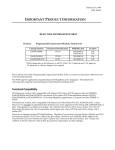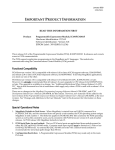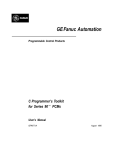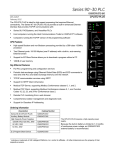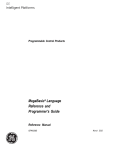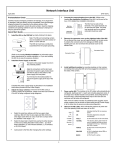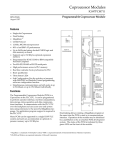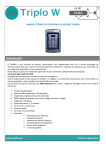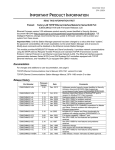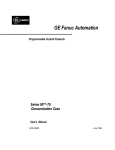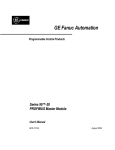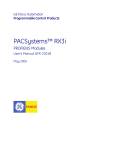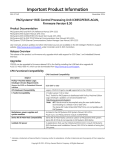Download Series 90-30, Programmable Coprocessor Module
Transcript
GFK-0494Z August 2011 IMPORTANT PRODUCT INFORMATION READ THIS INFORMATION FIRST Product: Series 90*-30 Programmable Coprocessor Modules IC693PCM300S, IC693PCM301R, IC693PCM311S Firmware Version 4.05 Note: For new and revised installation requirements for these modules, see Installation Requirements for Conformance to Standards, GFK-1179M or later. This release consists of a hardware change to resolve a component obsolescence issue. Features, performance and compatibility are not affected. Firmware Update Kits for Version 4.05 The following firmware upgrade kits are available at www.ge-ip.com/support. PCM Catalog Number Firmware Update Kit Number IC693PCM300P and later 44A731200-G10 IC693PCM301M and later 44A731222-G08 IC693PCM311N and later 44A731222-G08 Functional Compatibility This revision is fully compatible with previous revisions. User Manuals MegaBasic Programming Language Reference Manual, GFK-0256 PCM Development Software (PCOP) User’s Manual, GFK-0487 Programmable Coprocessor Module and Support Software User’s Manual, GFK-0255 (For pending changes to this manual, see page 4 Firmware Version 4.05 Details Firmware release 4.05 for the Series 90-30 Programmable Coprocessor Modules (PCM) corrects several minor software errors in CCM communication. The PCM modules support application programming in the MegaBasic and C languages, and communicate using the Communications Control Module (CCM) protocol. PCM firmware version 4.05 is compatible with release 1.00 or later of PCM support software (TERMF), IC641SWP063A and IC641SWP023A, and release 2.04 or later of PCM development software (PCOP), IC641SWP061B and IC641SWP021A. To develop MegaBasic applications, you must use either TERMF or PCOP. PCM firmware version 4.05 is compatible with release 1.03 of the Model 331 CPU, IC693CPU331C, or later. However, it is strongly recommended that all release 1.0x users upgrade to a later CPU release. This upgrade is available at no charge. See “Additional Restrictions When Using a Release 1.0x CPU 331” later in this document for a list of restrictions which apply only when a PCM is used with a release 1.05 or earlier CPU. indicates a trademark of GE Intelligent Platforms, Inc. and/or its affiliates. All other trademarks are the property of their respective owners. * 2 Important Product Information GFK-0494Z Special Operational Notes 1. Year 2000: Series 90 Programmable Coprocessor Modules (PCMs) provide time and date services to MegaBasic and C language applications. PCMs do not use time and date information internally. The time and date values provided by PCM services are obtained indirectly from the time-of-day clock in the PLC CPU. There is no capability for PCM users or applications to change the time or date in the PCM directly. Because the CPU time-of-day clock hardware contains two digits for the year, PCM date services provide a two-digit year value in the range 0 through 99 inclusive. Correct interpretation of the year value is an important issue for application designers. In previous PCM releases the G e t _ D a t e service for C language applications will return an incorrect year value during all or part of the first minute after midnight on January 1, 2000. The G e t _ D a t e problem has been corrected in this release. In all PCM releases, the MegaBasic D A T E $ function returns the correct year at all times. See the ”Problems Resolved by this Upgrade” section for details. 2. Latency of PCM Time and Date Changes: When a user or an application changes the PLC CPU time or date, the PCM local time and date (as reported by the G e t _ t i m e , T I M E $ , G e t _ D a t e and D A T E $ services) will not be updated immediately to the new values. The latency of the PCM local time and date changes depends on whether the PLC time, date or both are changed. When the PLC time changes, the PCM local time will be updated accordingly within one second. When the PLC time and date are both changed, the PCM local date will also be updated within about one second. However, when the PLC date is changed without changing the time, up to one minute may elapse before the PCM local date is updated. See the item “Synchronization of the PCM Local Time and Date With the PLC CPU” in the ”Changes and Additions to the User’s Manual” section for details. 3. MegaBasic Defaults to Task Seven: When MegaBasic is started from an R (RUN) command in a P C M E X E C . B A T file, and the command does not specify a task number, the PCM operating system assigns MegaBasic to task number 7. This behavior applies to P C M E X E C . B A T files created by the PCM operating system as well as files created by users, and is consistent with all PCM firmware versions except 3.00, where MegaBasic defaults to task 15. 4. PCM Serial Ports Are Not Isolated: The two PCM serial ports are not isolated from module ground in either RS-232C or RS-422/RS-485 mode. Common-mode input signals must be limited to 12 volts or less for RS-422/RS-485 mode. An external RS-232C/RS-485 converter with common-mode isolation is recommended for serial data paths longer than 50 feet. 5. Configuration Restriction: An IC693 Programmable Coprocessor Module (PCM) may reside only in the main PLC rack. 6. PROM Change: PCM RAM, including the RAM Disk (the RAM: device), is automatically cleared on the first power-up after the PCM PROM is changed. If RAM disk files must be preserved, they must be stored to an attached personal computer (PC), using TERMF or PCOP, before upgrading the PCM firmware, and loaded to the PCM after the upgrade. 7. Power-up Delay: The first COMMREQ sent to a PCM after a power cycle needs to be delayed until the PCM has finished power-up initialization. See the Programmable Coprocessor Module and Support Software User’s Manual for example PLC programs which delay before sending CCM and MegaBasic COMMREQs. New Features and Functionality in Release 4.05 WAIT Mode PCM Reset COMMREQs Now Supported: In previous PCM releases, COMMREQ commands to reset a PCM from a PLC application program were required to use NOWAIT mode. However, Series 90 CPUs will not, in general, issue more than one NOWAIT COMMREQ per sweep. PCMs now support WAIT mode reset COMMREQs so that two or more PCMs can be reset during the same PLC sweep. See “WAIT Mode PCM Reset COMMREQs” in the ”Changes and Additions to the User’s Manual” section for details. Problems Resolved by in Release 4.05 Important Product Information 3 GFK-0494Z PCM G e t _ D a t e service returns invalid year briefly at midnight on January 1, 2000: In previous PCM releases the Get_Date service for C language applications will return the year value 100 during all or part of the first minute after midnight on January 1, 2000. The year value will change to zero the first time the PCM local date is adjusted to the PLC date; this occurs once per minute. In release 4.05, Get_Date will return the year value 0 as expected after midnight on January 1, 2000. In all PCM releases, the MegaBasic DATE$ function returns the correct year at all times. Restrictions and Significant Open Issues 1. Invalid MegaBasic COMMREQ May Not Cause PLC Fault: When a MegaBasic COMMREQ message is sent to the PCM and MegaBasic is not executing, the expected fault message may occasionally not appear in the PLC fault table. 2. CCM Timeout On Large Requests: CCM requests for 3000 bytes or more of data may occasionally abort with a serial timeout error (Error code 0102H). 3. Redirection of MegaBasic STDIN: When MegaBasic is run with STDIN redirected from a file on an attached PC and execution of the MegaBasic program terminates for any reason, MegaBasic is unable to read input characters from the PC file. Redirecting STDIN from a PCM RAM disk file works correctly. 4. MegaBasic Serial Data Rate: When both PCM serial ports are configured for a data rate higher than 9600 bps and a MegaBasic program transmits and receives characters on both ports at the same time, the PCM watchdog timer may expire, halting operation and turning off the OK LED. 5. CCM Data Rate: Recoverable CCM communication errors, such as dropped characters, may occur when CCM initiates commands on both ports simultaneously at data rates above 9600 bps. It is recommended that the data rate on either CCM port not exceed 9600 bps when using both ports as initiators. 6. WAIT Mode COMMREQ: Programming the COMMREQ function block for WAIT mode will degrade PLC sweep time and may halt the PLC CPU, turning off its OK LED. Do not use WAIT mode COMMREQs unless you have a compelling reason. If WAIT mode is used, it is absolutely essential that no COMMREQs are sent until the PCM is ready to receive them, and that the sum of the worst-case PLC sweep time (without sending a COMMREQ) plus the longer of the two COMMREQ timeout values is less than the PLC CPU watchdog timer setting. If two or more WAIT mode COMMREQs can be sent during the same PLC sweep, the total of the timeouts for all the COMMREQs must be considered. See the Programmable Coprocessor Module and Support Software User’s Manual. 7. Extra Fault: When a WAIT mode COMMREQ which specifies an invalid PCM TASK ID is executed, two “Bad task id” faults are posted to the PLC fault table. 8. NOWAIT I/O and CTRL-C: If a MegaBasic program performs NOWAIT_READ and NOWAIT_WRITE operations simultaneously on the same serial port, and the program is aborted with CTRL-C or a MegaBasic STOP statement, the PCM may hang if the program is restarted before the I/O operations complete. Additional Restrictions When Using a Release 1.0x Model 331 CPU 1. Multiple PCMs and/or ADCs: When two or more PCMs and/or Access 90 Display Coprocessor modules (ADCs) which do not have identical catalog numbers are installed in a PLC system, the PCM/ADC modules may not function normally, particularly after a short power cycle (warm boot). “Loss of module” faults may be posted to the PLC fault table. 2. MegaBasic Data Length: If a MegaBasic program attempts to write more than 512 bytes of data to the PLC CPU in a single request, the CPU watchdog timer will expire, turning off the CPU OK LED. Lost COMMREQ: When two or more PCMs are present, a COMMREQ to either PCM may never complete. If a ladder program attempts to send WAIT mode COMMREQs, the CPU OK LED may go out after several minutes. 4 Important Product Information GFK-0494Z 3. Lost COMMREQ: When two or more PCMs are present, a COMMREQ to either PCM may never complete. If a ladder program attempts to send WAIT mode COMMREQs, the CPU OK LED may go out after several minutes. Ladder programs should always use NOWAIT mode COMMREQs. To ensure that transactions are completed, a time limit should be established for each COMMREQ using a PLC timer function block. When a COMMREQ fails to complete before its timer expires, the program can send it again. 4. PLC Configuration Change: When an I/O configuration is stored to the PLC, or a Hand Held Programmer operation (Autoconfig or clear PLC) results in a change to PCM configuration data, PCMs must be reset before the new configuration takes effect. When the PCM configuration is changed to correct a “Configuration mismatch” PLC fault, a PLC power cycle is required before the PCM will function normally. “Loss of module” PLC faults for the PCM will occur between the time the new configuration is stored and the power cycle. Changes and Additions to the User’s Manual The following items should be added to the Series 90 Programmable Coprocessor Module and Support Software User’s Manual, GFK-0255J. Synchronization of the PCM Local Time and Date with the PLC CPU PCMs maintain time and date information locally as two-digit values for the current year, month, day of month, day of week, hour, minute, second and hundredths of seconds. Each time a PCM is powered on or reset, it obtains the current time and date from the PLC CPU and uses these values to initialize its local time and date. Because the PLC CPU provides time values to the nearest second, the hundredths of seconds value is initialized to zero. The local time values are updated periodically on an interval of approximately 50 milliseconds from a one millisecond timer in the PCM. At each update, the number of milliseconds since the last update (or since initialization in the case of the first update) is rounded to the nearest hundredth of a second and added to the local time. The time and date values are adjusted as necessary when the hundredths of seconds value exceeds 99, etc. When the PCM G e t _ T i m e and T I M E $ services are invoked by a PCM application, the time values from the most recent update are adjusted by the number of milliseconds since the update. The PCM requests the current date and time of day from the PLC CPU once each minute and then adjusts it local time and date values accordingly. The PLC time is also obtained once each second. When the PLC time differs from the PCM local time by more than one second, the PCM local time is adjusted to the PLC time, and the PLC time and date are requested immediately rather than at the end of the current one minute interval. When a user or an application changes the PLC CPU time or date, the PCM local time will not be updated immediately to the new values. The latency of the PCM local time/date change depends on whether the PLC time, date or both are changed. When the PLC time changes, the PCM will detect the change within one second and update its local time accordingly. When the PLC time and date are both changed, the PCM will detect the time change, request the PLC time and date, and update both within about one second. However, when the PLC date is changed without changing the time, the PCM will not detect the date change for as long as one minute. WAIT Mode PCM Reset COMMREQs Two or more Series 90 PCMs in the same PLC can be reset during the same PLC sweep by using WAIT mode PCM reset COMMREQs provided that the PCMs have release 4.05 or later firmware installed. WAIT mode forces the PLC CPU to send a COMMREQ during the sweep when the COMMREQ function block executes. Important Product Information 5 GFK-0494Z Consequently, multiple PCMs can be reset in the same sweep by executing a separate COMMREQ for each one during the sweep. Because the PCMs never respond to reset COMMREQs, the WAIT mode timeout values can be made very short to minimize impact of the COMMREQ on sweep time. The table below shows COMMREQ data values for WAIT mode reset COMMREQs. COMMREQ Data Block Field Length Value 2 (2 Words) WAIT/NOWAIT Flag 1 (WAIT Mode) Status Pointer Memory Type 0 (This field is ignored.) Status Pointer Memory Offset 0 (This field is ignored.) Idle Timeout Value 1 (100 Microseconds) Maximum Communication Time 1 (100 Microseconds) Reset Status Value 0 (This field is ignored.) Reset Command Value 4320 Hexadecimal (Soft Reset) 8640 Hexadecimal (Hard Reset) Installation in Hazardous Locations The following information is for products bearing the UL marking for Hazardous Locations (PCM301 and PCM311): WARNING - EXPLOSION HAZARD - SUBSTITUTION OF COMPONENTS MAY IMPAIR SUITABILITY FOR CLASS I, DIVISION 2; WARNING - EXPLOSION HAZARD - WHEN IN HAZARDOUS LOCATIONS, TURN OFF POWER BEFORE REPLACING OR WIRING MODULES; AND WARNING - EXPLOSION HAZARD - DO NOT CONNECT OR DISCONNECT EQUIPMENT UNLESS POWER HAS BEEN SWITCHED OFF OR THE AREA IS KNOWN TO BE NONHAZARDOUS. EQUIPMENT LABELED WITH REFERENCE TO CLASS I, GROUPS A, B, C & D, DIV. 2 HAZARDOUS LOCATIONS IS SUITABLE FOR USE IN CLASS I, DIVISION 2, GROUPS A, B, C, D OR NONHAZARDOUS LOCATIONS ONLY.






